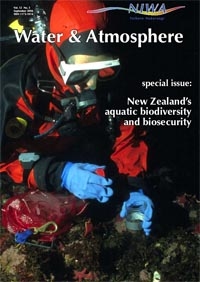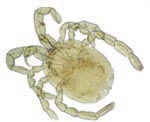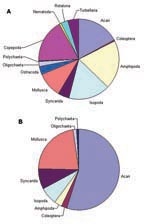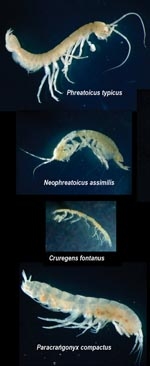PDF of this article (195 KB)

Graham Fenwick Mike Scarsbrook
NIWA research has discovered a biodiversity treasure trove in New Zealand’s aquifers, often living more than 20 m beneath the soil surface.
There’s life in groundwater: highly specialised species of invertebrates have adapted to complete their entire life-histories in lightless, subterranean waters. Unusual they may seem, but only because of their unfamiliarity.



How diverse?
So far, New Zealand’s known (formally named) groundwater biodiversity comprises 130 species. Most are small aquatic mites (71 species). Snails are less diverse, with 29 species. Crustaceans (well shrimps) have 15 described species. The known diversity is already quite impressive but, if you consider that most collecting to date has been in a small number of locations, there are almost certainly many, many more species awaiting discovery and naming. For example, preliminary work indicates that our collections hold at least 20 additional species of amphipods, even though these collections come from only a few parts of the country. And 19 of the 29 known groundwater snail species were only recently described by a NIWA post-doctoral scientist.
Just how many species are likely to be present in New Zealand’s groundwaters is uncertain. We can make a rough estimate by looking at the diversities of better-known groups as indicators of the total faunal diversity. The best-known group of New Zealand stygofauna (specialised aquatic animals that complete their entire life histories in subterranean habitats) is the water mites or Acari. Most of these were described as a result of concerted collecting in the 1970s by Dr G. Kuschel (DSIR Entomology Division) and taxonomic research by Dr D.R. Cook in the 1980s. A review of the world’s groundwater fauna published by L. Botosaneanu in 1986 found that mites comprised 17% of the known 3410 stygofaunal species inhabiting the world, although additional species of water mites and other stygofaunal invertebrates have since been found and others await discovery.
Assuming that water mites comprise the same percentage of all the stygofaunal species in New Zealand as in the rest of the world, then we would estimate 418 species. Applying the same approach using snails, which comprised 10% of the world stygofauna in 1986, our 29 species might indicate a total of 290 stygofaunal species in New Zealand. As an educated guess, we think that the actual number will be 2–4 times higher than these estimates, because most collections of New Zealand water mites came from wells near Nelson, suggesting that collections from groundwaters elsewhere around the country will yield even more species. In addition, better collecting and taxonomic techniques in use today show even more stygofaunal species than initially identified, both worldwide and in New Zealand.
Another way to look at our groundwater biodiversity is to compare New Zealand’s contribution to world stygofaunal biodiversity. Using Botosaneanu’s 1986 data again, New Zealand contributed 3.8% of world’s known stygofaunal species from just 0.18% of the world’s land area!
Why so diverse?
Should we be surprised at such a rich species diversity? Probably not. A number of features of New Zealand groundwaters may have contributed to the apparent high diversity. First, groundwaters underlie a very large portion of New Zealand, particularly when compared with other freshwater habitats, such as lakes and rivers. Second, there is a diverse array of groundwater habitat types throughout New Zealand, including porous aquifers in a range of geologies, karst systems in limestone and marble, and fractured rock aquifers. Third, New Zealand’s active volcanic, glacial and tectonic past has led to long-term separation of habitats and populations. In combination, these factors may have driven rapid speciation, particularly among the hydrobiid snails, so that today’s stygofauna is highly diverse. Of course, the associated high endemism (that is, many species are confined to very restricted geographical ranges) makes protecting our indigenous biodiversity more difficult. It is practically impossible to protect all groundwater habitats and their resident faunas from the potential threats and stressors from human activities. These include agricultural development, over-pumping of aquifers, and pesticide use.
Taxonomic challenge
NIWA’s FRST-funded groundwater biodiversity programme now has significant collections of stygofauna for taxonomic investigation. In addition to many new species of amphipods, this collection includes numerous isopods, copepods, ostracods, syncarids, water mites, flatworms, hydrozoans, gastropods, oligochaetes, polychaetes, and nematodes. The key species, if not all species, within this diverse fauna must be scientifically defined (taxonomy does this and assigns scientific names) before species’ distributions and ecological requirements can be identified, and ecological research carried out to improve management of groundwater ecosystems.
The remarkably high diversity within New Zealand means that there is much to do to describe our groundwater fauna and provide other scientists with the ability to discriminate amongst different species. This work presents a significant challenge for the country’s limited taxonomic capacity, so that local and international taxonomists will be involved. Ultimately, the results of this taxonomic work will enable ecological research to support improved management of New Zealand’s invaluable groundwater resources.
Further reading
Botosaneanu, L. (ed.) (1986). Stygofauna mundi: A faunistic, distributional, and ecological synthesis of the world fauna inhabiting subterranean waters (including the marine interstitial). E.J. Brill/Backhys, Leiden, The Netherlands. 740 p.
Cook, D.R. (1983). Rheophilic and hyporheic water mites of New Zealand. Contributions of the American Entomological Institiute 21: 1–224.
Cook, D.R. (1991). Water mites from driven wells in New Zealand, the subfamily Notoaturinae. Stygologia 6: 235–253.
Cook, D.R. (1992). Water mites (Hydracarina), mostly from driven wells in New Zealand: taxa other that the Notoaturinae Besch. Stygologia 7: 43–52.
Scarsbrook, M.R.; Fenwick, G.D.; Duggan, I.C.; Haase, M. (2003). A guide to the groundwater invertebrates of New Zealand. NIWA Science & Technology Series 51. 59 p.
White, P.A. (2001). Groundwater resources of New Zealand. In: Rosen, M.R.; White, P.A. (eds). Groundwaters of New Zealand, pp. 45–75. New Zealand Hydrological Society, Wellington.
Graham Fenwick is based at NIWA in Christchurch; Mike Scarsbrook is a NIWA in Hamilton.
Teachers’ resource for NCEA AS: Biology 2.5, 2.6, 2.9, 3.5. See other curriculum connections at www.niwa.co.nz/pubs/wa/resources
